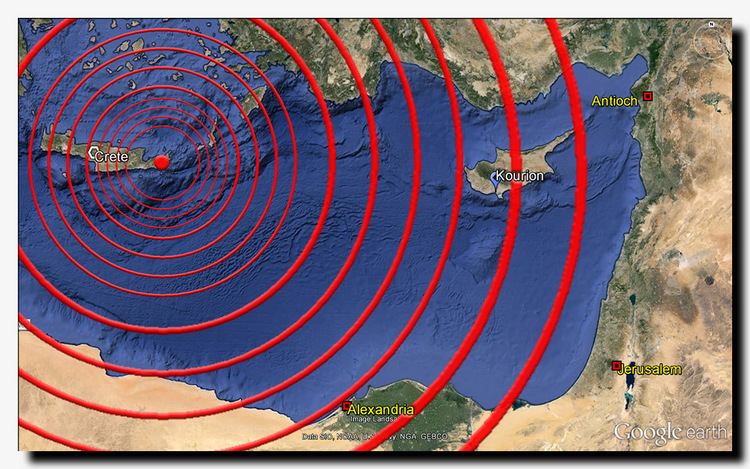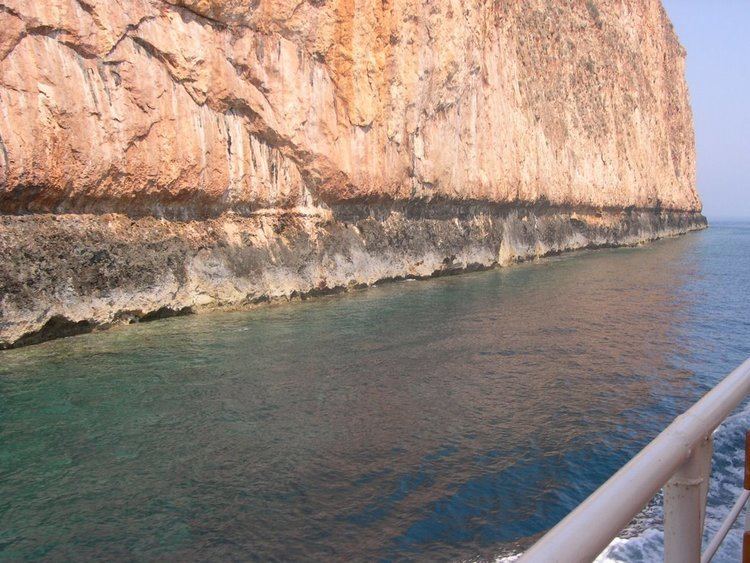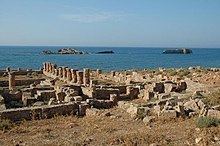Magnitude 8.5+ Max. intensity XI (Extreme) Casualties "many thousands" | Tsunami Yes Date 21 July 365 AD | |
 | ||
Similar 226 BC Rhodes earthquake, 1953 Ionian earthquake, 1999 Athens earthquake, 2008 Peloponnese earthquake, 1960 Valdivia earthquake | ||
365 crete earthquake
The AD 365 Crete earthquake occurred at about sunrise on 21 July in the Eastern Mediterranean, with an assumed epicentre near Crete. Geologists today estimate the undersea earthquake to have been a magnitude eight or higher, causing widespread destruction in central and southern Greece, northern Libya, Egypt, Cyprus, Sicily, and Spain. In Crete, nearly all towns were destroyed.
Contents

The Crete earthquake was followed by a tsunami which devastated the southern and eastern coasts of the Mediterranean, particularly Libya, Alexandria and the Nile Delta, killing thousands and hurling ships 3 km (1.9 mi) inland. The quake left a deep impression on the late antique mind, and numerous writers of the time referred to the event in their works.

Geological evidence

Recent (2001) geological studies view the AD 365 Crete earthquake in connection with a clustering of major seismic activity in the Eastern Mediterranean between the fourth and sixth century AD which may have reflected a reactivation of all major plate boundaries in the region. The earthquake is thought to be responsible for an uplift of nine metres of the island of Crete, which is estimated to correspond to a seismic moment of ~1029 dyne cm. An earthquake of such a size exceeds all modern ones known to have affected the region.

Carbon dating shows that corals on the coast of Crete were lifted ten metres and clear of the water in one massive push. This indicates that the tsunami of AD 365 was generated by an earthquake in a steep fault in the Hellenic Trench near Crete. The scientists estimate that such a large uplift is only likely to occur once in 5,000 years; however, the other segments of the fault could slip on a similar scale—and this could happen every 800 years or so. It is unsure whether "one of the contiguous patches might slip in the future."
Literary evidence
Historians continue to debate the question whether ancient sources refer to a single catastrophic earthquake in AD 365, or whether they represent a historical amalgamation of a number of earthquakes occurring between AD 350 and 450. The interpretation of the surviving literary evidence is complicated by the tendency of late antique writers to describe natural disasters as divine responses or warnings to political and religious events. In particular, the virulent antagonism between rising Christianity and paganism at the time led contemporary writers to distort the evidence. Thus, the Sophist Libanius and the church historian Sozomenus appear to conflate the great earthquake of AD 365 with other lesser ones to present it as either divine sorrow or wrath—depending on their viewpoint—for the death of Emperor Julian, who had tried to restore the pagan religion two years earlier.
On the whole, however, the relatively numerous references to earthquakes in a time which is otherwise characterized by a paucity of historical records strengthens the case for a period of heightened seismic activity. Kourion on Cyprus, for example, is known to have been hit then by five strong earthquakes within a period of eighty years, leading to its permanent destruction.
Archeology
Archeological evidence for the particularly devastating effect of the AD 365 earthquake is provided by a survey of excavations which document the destruction of most late antique towns and cities in the Eastern and Southern Mediterranean around AD 365.
Tsunami
The Roman historian Ammianus Marcellinus described in detail the tsunami hitting Alexandria and other places in the early hours of 21 July AD 365. His account is particularly noteworthy for clearly distinguishing the three main phases of a tsunami, namely an initial earthquake, the sudden retreat of the sea and an ensuing gigantic wave rolling inland:
Slightly after daybreak, and heralded by a thick succession of fiercely shaken thunderbolts, the solidity of the whole earth was made to shake and shudder, and the sea was driven away, its waves were rolled back, and it disappeared, so that the abyss of the depths was uncovered and many-shaped varieties of sea-creatures were seen stuck in the slime; the great wastes of those valleys and mountains, which the very creation had dismissed beneath the vast whirlpools, at that moment, as it was given to be believed, looked up at the sun's rays. Many ships, then, were stranded as if on dry land, and people wandered at will about the paltry remains of the waters to collect fish and the like in their hands; then the roaring sea as if insulted by its repulse rises back in turn, and through the teeming shoals dashed itself violently on islands and extensive tracts of the mainland, and flattened innumerable buildings in towns or wherever they were found. Thus in the raging conflict of the elements, the face of the earth was changed to reveal wondrous sights. For the mass of waters returning when least expected killed many thousands by drowning, and with the tides whipped up to a height as they rushed back, some ships, after the anger of the watery element had grown old, were seen to have sunk, and the bodies of people killed in shipwrecks lay there, faces up or down. Other huge ships, thrust out by the mad blasts, perched on the roofs of houses, as happened at Alexandria, and others were hurled nearly two miles from the shore, like the Laconian vessel near the town of Methone which I saw when I passed by, yawning apart from long decay.The tsunami in AD 365 was so devastating that the anniversary of the disaster was still commemorated annually at the end of the sixth century in Alexandria as a "day of horror". The Roman Emperor Valentinian I sent an investigator to find out about problems with the tax situation.
Gallery
Effects of the earthquake visible in the ancient remains:
